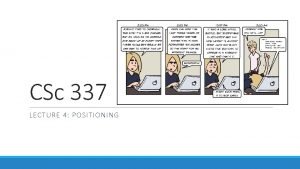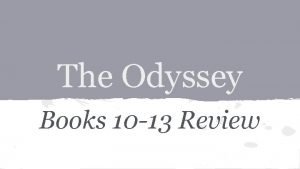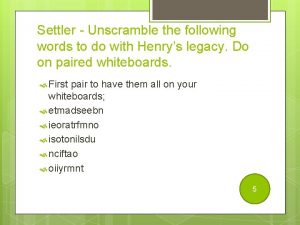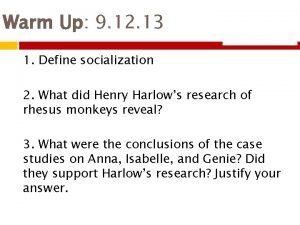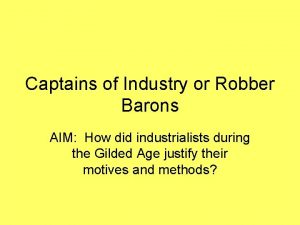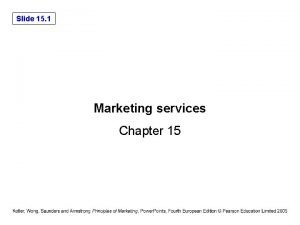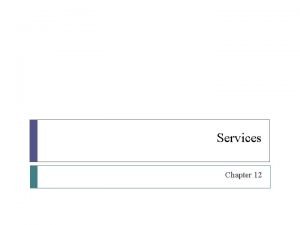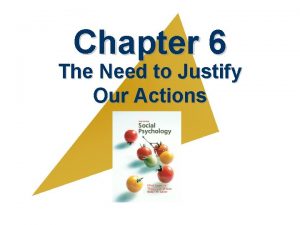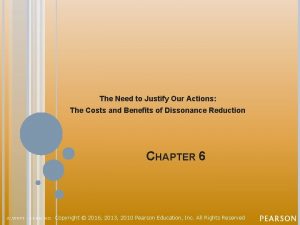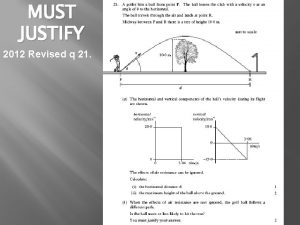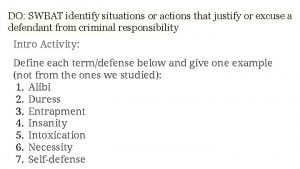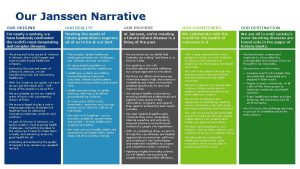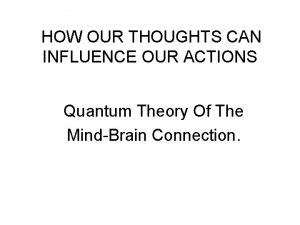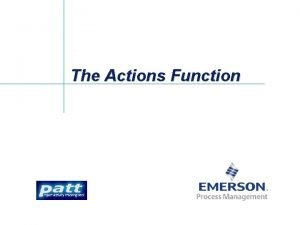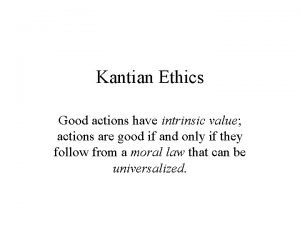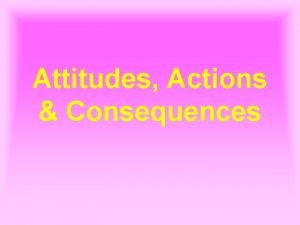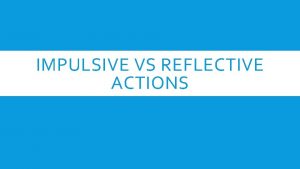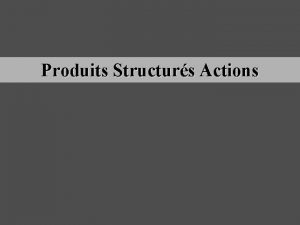Chapter 6 The Need to Justify Our Actions














































































- Slides: 78

Chapter 6 The Need to Justify Our Actions: The Costs and Benefits of Dissonance Reduction Slides prepared by Jo. Nell Strough, Ph. D. & Philip Lemaster, M. A. West Virginia University Social Psychology, Eighth Edition Elliot Aronson | Timothy D. Wilson | Robin M. Akert © 2013 Pearson Education, Inc. All Rights Reserved.

This multimedia product and its contents are protected under copyright law. The following are prohibited by law: any public performance or display, including transmission of any image over a network; preparation of any derivative work, including the extraction, in whole or in part, of any images; any rental, lease, or lending of the program. Social Psychology, Eighth Edition Elliot Aronson | Timothy D. Wilson | Robin M. Akert © 2013 Pearson Education, Inc. All Rights Reserved.

Multimedia Directory Slide 15 26 45 51 Dissonance Reduction Video Lowballing Video Hazing Video External Justification Video Social Psychology, Eighth Edition Elliot Aronson | Timothy D. Wilson | Robin M. Akert © 2013 Pearson Education, Inc. All Rights Reserved.

Heaven’s Gate Cult • Believed that a space ship was coming to transport them – Needed to rid selves of “current containers” (own body) – Spaceship failed to appear behind Hale. Bopp Comet – Continued with plan anyway • Mass suicide • Extreme example of Need to Justify Actions Social Psychology, Eighth Edition Elliot Aronson | Timothy D. Wilson | Robin M. Akert © 2013 Pearson Education, Inc. All Rights Reserved.

Maintaining a Stable, Positive Self-Image • As humans, we strive to maintain a favorable view of ourselves • When confronted with unfavorable view of self – Experience discomfort Social Psychology, Eighth Edition Elliot Aronson | Timothy D. Wilson | Robin M. Akert © 2013 Pearson Education, Inc. All Rights Reserved.

The Theory of Cognitive Dissonance • Feeling of discomfort caused by performing an action that runs counter to one’s customary (typically positive) conception of oneself is referred to as cognitive dissonance. Social Psychology, Eighth Edition Elliot Aronson | Timothy D. Wilson | Robin M. Akert © 2013 Pearson Education, Inc. All Rights Reserved.

The Theory of Cognitive Dissonance (Festinger, 1957) • Important and provocative social psychological theory • Threats to self-image – Induces powerful, upsetting dissonance Social Psychology, Eighth Edition Elliot Aronson | Timothy D. Wilson | Robin M. Akert © 2013 Pearson Education, Inc. All Rights Reserved.

Three Ways to Reduce Dissonance 1. Change behavior 2. Justify behavior by changing one of the dissonant cognitions 3. Justify behavior by adding new cognitions Social Psychology, Eighth Edition Elliot Aronson | Timothy D. Wilson | Robin M. Akert © 2013 Pearson Education, Inc. All Rights Reserved.

Figure 6. 1 How We Reduce Cognitive Dissonance There are three basic ways of reducing dissonance: change your behavior, change your cognition, or add a new cognition. Social Psychology, Eighth Edition Elliot Aronson | Timothy D. Wilson | Robin M. Akert © 2013 Pearson Education, Inc. All Rights Reserved.

Self-Affirmation • Bolster the self-concept • Reducing dissonance by adding a cognition about other positive attributes – E. g. , smoker who fails to quit • Not very smart of me to be smoking, but, I’m really a very good mathematician! Social Psychology, Eighth Edition Elliot Aronson | Timothy D. Wilson | Robin M. Akert © 2013 Pearson Education, Inc. All Rights Reserved.

Impact Bias • The tendency to overestimate the intensity and duration of our emotional reactions to future negative events. Social Psychology, Eighth Edition Elliot Aronson | Timothy D. Wilson | Robin M. Akert © 2013 Pearson Education, Inc. All Rights Reserved.

Teenagers who smoke usually justify their actions with such cognitions as “Smoking is cool”; “I want to be like my friends”; “in movies, everyone smokes”; “I’m healthy; nothing is going to happen to me”; or “adults are always on my back about stuff I do” Source: Powell John/Prisma/Age Fotostock Social Psychology, Eighth Edition Elliot Aronson | Timothy D. Wilson | Robin M. Akert © 2013 Pearson Education, Inc. All Rights Reserved.

Why We Overestimate the Pain of Disappointment • Why does impact bias occur? – Process of reducing dissonance is largely unconscious Social Psychology, Eighth Edition Elliot Aronson | Timothy D. Wilson | Robin M. Akert © 2013 Pearson Education, Inc. All Rights Reserved.

Self-Esteem and Cognitive Dissonance • High self-esteem – Strive to keep behavior consonant with view of self • Work harder to reduce dissonance than people with average self-esteem Social Psychology, Eighth Edition Elliot Aronson | Timothy D. Wilson | Robin M. Akert © 2013 Pearson Education, Inc. All Rights Reserved.

Dissonance Reduction Video Click on the screenshot to watch Dr. Tavris discuss how dissonance reduction is often oriented toward protecting self-esteem. Back to Directory Social Psychology, Eighth Edition Elliot Aronson | Timothy D. Wilson | Robin M. Akert © 2013 Pearson Education, Inc. All Rights Reserved.

Rational Behavior Versus Rationalizing Behavior • Need to maintain our self-esteem – Associated with rationalizing instead of rational thought • Process information so that it fits with preexisting beliefs Social Psychology, Eighth Edition Elliot Aronson | Timothy D. Wilson | Robin M. Akert © 2013 Pearson Education, Inc. All Rights Reserved.

Decisions, Decisions • Every time we make a decision, we experience dissonance. – Chosen alternative has some negative aspects – Rejected alternative has some positive aspects Social Psychology, Eighth Edition Elliot Aronson | Timothy D. Wilson | Robin M. Akert © 2013 Pearson Education, Inc. All Rights Reserved.

Once he is hooked on getting a truck, this young man will reason that “it certainly would be safer than a small car, and besides, the price of gasoline is bound to drop by the time I’m 40. ” Source: Jeremy Woodhouse/Blend Images/Age Fotostock Social Psychology, Eighth Edition Elliot Aronson | Timothy D. Wilson | Robin M. Akert © 2013 Pearson Education, Inc. All Rights Reserved.

Postdecision Dissonance • Dissonance aroused after making a decision, typically reduced by enhancing the attractiveness of the chosen alternative and devaluating the rejected alternatives. Social Psychology, Eighth Edition Elliot Aronson | Timothy D. Wilson | Robin M. Akert © 2013 Pearson Education, Inc. All Rights Reserved.

Reducing Post-Decision Dissonance • Distort likes and dislikes – Downplay • Negative aspects of chosen alternative • Positive aspects of rejected alternative Social Psychology, Eighth Edition Elliot Aronson | Timothy D. Wilson | Robin M. Akert © 2013 Pearson Education, Inc. All Rights Reserved.

Permanence and Importance of Decision • More important decisions = More dissonance • Greater permanence = More dissonance – Permanence of decision • How difficult it is to revoke Social Psychology, Eighth Edition Elliot Aronson | Timothy D. Wilson | Robin M. Akert © 2013 Pearson Education, Inc. All Rights Reserved.

All sales are final. When will this customer be happier with her new flatscreen TV: ten minutes before the purchase? Ten minutes after the purchase? Source: Newscast/Alamy Social Psychology, Eighth Edition Elliot Aronson | Timothy D. Wilson | Robin M. Akert © 2013 Pearson Education, Inc. All Rights Reserved.

Creating the Illusion of Irrevocability • When decisions are permanent (irrevocable) – Dissonance increases – Motivation to reduce dissonance increases Social Psychology, Eighth Edition Elliot Aronson | Timothy D. Wilson | Robin M. Akert © 2013 Pearson Education, Inc. All Rights Reserved.

Creating the Illusion of Irrevocability • Lowballing – An unscrupulous strategy whereby a salesperson induces a customer to agree to purchase a product at a very low cost, subsequently claims it was an error, and then raises the price. – Frequently, the customer will agree to make the purchase at the inflated price. Social Psychology, Eighth Edition Elliot Aronson | Timothy D. Wilson | Robin M. Akert © 2013 Pearson Education, Inc. All Rights Reserved.

Creating the Illusion of Irrevocability • Create illusion of irrevocability to induce motivation to reduce dissonance! Social Psychology, Eighth Edition Elliot Aronson | Timothy D. Wilson | Robin M. Akert © 2013 Pearson Education, Inc. All Rights Reserved.

Lowballing Video Click on the screenshot to watch Dr. Cialdini briefly explain how car salesmen use lowballing to increase their sales. Back to Directory Social Psychology, Eighth Edition Elliot Aronson | Timothy D. Wilson | Robin M. Akert © 2013 Pearson Education, Inc. All Rights Reserved.

The Decision to Behave Immorally • When is it okay to lie to a friend? • When is an act of stealing, and when is it borrowing? Social Psychology, Eighth Edition Elliot Aronson | Timothy D. Wilson | Robin M. Akert © 2013 Pearson Education, Inc. All Rights Reserved.

After he cheats, this student will try to convince himself that everybody would cheat if they had the chance. Source: Pixtal/Glow Images, Inc. Social Psychology, Eighth Edition Elliot Aronson | Timothy D. Wilson | Robin M. Akert © 2013 Pearson Education, Inc. All Rights Reserved.

The Decision to Behave Immorally • Moral dilemmas – Implications for self-esteem • Dissonance reduction – People may behave either more ethically or less ethically in the future Social Psychology, Eighth Edition Elliot Aronson | Timothy D. Wilson | Robin M. Akert © 2013 Pearson Education, Inc. All Rights Reserved.

The Decision to Behave Immorally • Example—Cheating on a test – Dissonance • Positive view of self inconsistent with dishonest behavior – How to reduce dissonance? • Change attitude about cheating – “Not a big deal, everyone does it” – Future behavior—less ethical Social Psychology, Eighth Edition Elliot Aronson | Timothy D. Wilson | Robin M. Akert © 2013 Pearson Education, Inc. All Rights Reserved.

Figure 6. 2 The Cheating Pyramid Imagine two students taking an exam. Both are tempted to cheat. Initially, their attitudes toward cheating are almost identical, but then one impulsively cheats and the other does not. Their attitudes will then undergo predictable changes. (Created by Carol Tavris. Used by permission. ) Social Psychology, Eighth Edition Elliot Aronson | Timothy D. Wilson | Robin M. Akert © 2013 Pearson Education, Inc. All Rights Reserved.

The Decision to Behave Immorally • Example—Cheating on a test – Change behavior • Do not ever cheat again • Future behavior—more ethical Social Psychology, Eighth Edition Elliot Aronson | Timothy D. Wilson | Robin M. Akert © 2013 Pearson Education, Inc. All Rights Reserved.

The Decision to Behave Immorally • Example—Decide NOT to cheat – Post-decision dissonance • “Would have received better grade if cheated” – Reducing dissonance • Change attitude – To justify giving up a good grade, you convince yourself that cheating is even worse than you previously felt it was • Attitude becomes more extreme Social Psychology, Eighth Edition Elliot Aronson | Timothy D. Wilson | Robin M. Akert © 2013 Pearson Education, Inc. All Rights Reserved.

Dissonance Reduction and Personal Values (Mills, 1958) • Measured 6 th graders attitudes about cheating • Gave opportunity to cheat in a game – Easy to cheat – Cheating almost necessary to win – Believed cheating could not be detected Social Psychology, Eighth Edition Elliot Aronson | Timothy D. Wilson | Robin M. Akert © 2013 Pearson Education, Inc. All Rights Reserved.

Dissonance Reduction and Personal Values (Mills, 1958) • Cheaters – Became more lenient toward cheating • Noncheaters – Became less lenient toward cheating Social Psychology, Eighth Edition Elliot Aronson | Timothy D. Wilson | Robin M. Akert © 2013 Pearson Education, Inc. All Rights Reserved.

Dissonance, Culture, and the Brain • Dissonant information – Reasoning circuits of brain shut down • Dissonance is reduced – Emotion circuits activated • Primates also show changes in what is valued after making a decision Social Psychology, Eighth Edition Elliot Aronson | Timothy D. Wilson | Robin M. Akert © 2013 Pearson Education, Inc. All Rights Reserved.

Dissonance and Culture • Process of dissonance reduction – Culturally universal • Content of dissonance reduction – Cultural differences • What thoughts are added, changed differ by culture Social Psychology, Eighth Edition Elliot Aronson | Timothy D. Wilson | Robin M. Akert © 2013 Pearson Education, Inc. All Rights Reserved.

Justifying Your Effort • Example – Suppose you expend a great deal of effort to get into a particular club and it turns out to be a totally worthless organization • How would you reduce this dissonance? • How would you justify your behavior? Social Psychology, Eighth Edition Elliot Aronson | Timothy D. Wilson | Robin M. Akert © 2013 Pearson Education, Inc. All Rights Reserved.

The harsh training required to become a marine will increase the recruits’ feelings of cohesiveness and their pride in the corps. Source: moodboard/Fotolia Social Psychology, Eighth Edition Elliot Aronson | Timothy D. Wilson | Robin M. Akert © 2013 Pearson Education, Inc. All Rights Reserved.

Justifying Your Effort • People may interpret ambiguities in a positive way when it helps to justify effort Justification of Effort The tendency for individuals to increase their liking for something they have worked hard to attain. Social Psychology, Eighth Edition Elliot Aronson | Timothy D. Wilson | Robin M. Akert © 2013 Pearson Education, Inc. All Rights Reserved.

Effort Justification (Aronson and Mills, 1959) • Cover story – College students volunteered to join a group that would be meeting regularly to discuss various aspects of the psychology of sex Social Psychology, Eighth Edition Elliot Aronson | Timothy D. Wilson | Robin M. Akert © 2013 Pearson Education, Inc. All Rights Reserved.

Effort Justification (Aronson and Mills, 1959) • IV – Severity of group initiation • 1/3 participants extremely demanding & unpleasant initiation • 1/3 mildly unpleasant • 1/3 admitted to group without any initiation • DV – Liking of group after admitted Social Psychology, Eighth Edition Elliot Aronson | Timothy D. Wilson | Robin M. Akert © 2013 Pearson Education, Inc. All Rights Reserved.

Effort Justification (Aronson and Mills, 1959) • Mild initiation or no effort less liking of group • Severe initiation more liking of group Social Psychology, Eighth Edition Elliot Aronson | Timothy D. Wilson | Robin M. Akert © 2013 Pearson Education, Inc. All Rights Reserved.

Figure 6. 3 The Justification of Effort The more effort we put into becoming members of a group, and the tougher the initiation, the more we will like the group we have just joined—even if it turns out to be a dud. (Adapted from Aronson & Mills, 1959. ) Social Psychology, Eighth Edition Elliot Aronson | Timothy D. Wilson | Robin M. Akert © 2013 Pearson Education, Inc. All Rights Reserved.

Hazing Video Click on the screenshot to watch a video on the topic of hazing. While hazing may increase affiliation with a group, it can also be dangerous. Back to Directory Social Psychology, Eighth Edition Elliot Aronson | Timothy D. Wilson | Robin M. Akert © 2013 Pearson Education, Inc. All Rights Reserved.

The Psychology of Insufficient Justification • Example – If you tell a friend that you like her ugly dress very much, do you experience much dissonance? • Many thoughts are consonant (consistent) with having told lie – E. g. , it is important not to cause pain to people, not hurt feelings Social Psychology, Eighth Edition Elliot Aronson | Timothy D. Wilson | Robin M. Akert © 2013 Pearson Education, Inc. All Rights Reserved.

The Psychology of Insufficient Justification • Believing it is important not to cause pain to people you like provides ample external justification for having told lie External Justification A reason or an explanation for dissonant personal behavior that resides outside the individual. E. g. , in order to receive a large reward or avoid a severe punishment. Social Psychology, Eighth Edition Elliot Aronson | Timothy D. Wilson | Robin M. Akert © 2013 Pearson Education, Inc. All Rights Reserved.

The Psychology of Insufficient Justification • What if there is no good external justification for lying? Social Psychology, Eighth Edition Elliot Aronson | Timothy D. Wilson | Robin M. Akert © 2013 Pearson Education, Inc. All Rights Reserved.

The Psychology of Insufficient Justification • Internal Justification – The reduction of dissonance by changing something about oneself. – E. g. , one’s attitude or behavior Social Psychology, Eighth Edition Elliot Aronson | Timothy D. Wilson | Robin M. Akert © 2013 Pearson Education, Inc. All Rights Reserved.

The Psychology of Insufficient Justification • If there is insufficient external justification for counterattitudinal advocacy, the attempt to reduce dissonance may result in attitude change! Counterattitudinal Advocacy Stating an opinion or attitude that runs counter to one’s private belief or attitude. Social Psychology, Eighth Edition Elliot Aronson | Timothy D. Wilson | Robin M. Akert © 2013 Pearson Education, Inc. All Rights Reserved.

External Justification Video Click on the screenshot to watch an example of how a woman uses external justification to explain why she engaged in counterattitudinal advocacy. Back to Directory Social Psychology, Eighth Edition Elliot Aronson | Timothy D. Wilson | Robin M. Akert © 2013 Pearson Education, Inc. All Rights Reserved.

Festinger and Carlsmith (1958) • Cover story – The effect of “interest instructions” on performance on a boring task Social Psychology, Eighth Edition Elliot Aronson | Timothy D. Wilson | Robin M. Akert © 2013 Pearson Education, Inc. All Rights Reserved.

Festinger and Carlsmith (1958) • IV = $ for telling a lie – $ 20. 00 large external justification “sufficient” – $ 1. 00, small external justification “insufficient” – control no $, no lie • DV = enjoyment of the task Social Psychology, Eighth Edition Elliot Aronson | Timothy D. Wilson | Robin M. Akert © 2013 Pearson Education, Inc. All Rights Reserved.

Festinger and Carlsmith (1958) • Students paid $20 for lying—for saying that the tasks had been enjoyable – Rated the task as dull and boring – $20 was sufficient external justification for lying • $20 reduced dissonance between positive view of self (honest person) & behavior (lying) – Lied because was paid to do so Social Psychology, Eighth Edition Elliot Aronson | Timothy D. Wilson | Robin M. Akert © 2013 Pearson Education, Inc. All Rights Reserved.

Festinger and Carlsmith (1958) • Students paid only $1 for lying (saying the boring task was fun) – Rated the task as significantly more enjoyable – External justification was insufficient – Reduced dissonance via internal justification • Changed attitude about task • Believed the lie they told Social Psychology, Eighth Edition Elliot Aronson | Timothy D. Wilson | Robin M. Akert © 2013 Pearson Education, Inc. All Rights Reserved.

Punishment and Self-Persuasion • If threat of punishment for engaging in a forbidden behavior is severe – There is sufficient external justification for refraining from behavior • If punishment is less severe – There is insufficient external justification – Creates greater need for internal justification • Change attitudes via self-persuasion Social Psychology, Eighth Edition Elliot Aronson | Timothy D. Wilson | Robin M. Akert © 2013 Pearson Education, Inc. All Rights Reserved.

Punishment and Self-Persuasion • Insufficient Punishment – The dissonance aroused when individuals lack sufficient external justification for having resisted a desired activity or object, usually resulting in individuals’ devaluing the forbidden activity or object. . Social Psychology, Eighth Edition Elliot Aronson | Timothy D. Wilson | Robin M. Akert © 2013 Pearson Education, Inc. All Rights Reserved.

Punishment and Self-Persuasion • When external justification for resisting an object or activity is insufficient: – Dissonance is aroused – Reduce dissonance by • Self-persuasion – E. g. , devaluing forbidden activity or object Social Psychology, Eighth Edition Elliot Aronson | Timothy D. Wilson | Robin M. Akert © 2013 Pearson Education, Inc. All Rights Reserved.

Parents can intervene to stop one sibling from tormenting another right at the moment of the incident, but what might they do to make it less likely to happen in the future? Source: Shannon Fagan/The Image Bank/Getty Images Social Psychology, Eighth Edition Elliot Aronson | Timothy D. Wilson | Robin M. Akert © 2013 Pearson Education, Inc. All Rights Reserved.

Forbidden Toy Study (Aronson and Carlsmith 1963) • Children rated the attractiveness of toys, then were forbidden to play with toy they found most attractive • IV = Severity of threatened punishment – ½ children threat of mild punishment if they disobeyed & played with toy – ½ children threat of severe punishment • DV = Rating of toy attractiveness Social Psychology, Eighth Edition Elliot Aronson | Timothy D. Wilson | Robin M. Akert © 2013 Pearson Education, Inc. All Rights Reserved.

Forbidden Toy Study (Aronson and Carlsmith 1963) • Threat of severe punishment – Forbidden toy remained highly attractive • No change in attitude • Had sufficient external justification for resisting toy Social Psychology, Eighth Edition Elliot Aronson | Timothy D. Wilson | Robin M. Akert © 2013 Pearson Education, Inc. All Rights Reserved.

Forbidden Toy Study (Aronson and Carlsmith 1963) • Threat of mild punishment – Forbidden toy was rated as less attractive – External justification was insufficient – Resolved dissonance through internal justification • Change attitude about toy Social Psychology, Eighth Edition Elliot Aronson | Timothy D. Wilson | Robin M. Akert © 2013 Pearson Education, Inc. All Rights Reserved.

Figure 6. 4 The Forbidden Toy Experiment Children who had received a threat of mild punishment were far less likely to play with a forbidden toy (orange bar) than children who had received a threat of severe punishment (blue bar). Those given a mild threat had to provide their own justification by devaluing the attractiveness of the toy (“I didn’t want to play with it anyhow”). The resulting self-persuasion lasted for weeks. (Based on data in Freedman, 1965. ) Social Psychology, Eighth Edition Elliot Aronson | Timothy D. Wilson | Robin M. Akert © 2013 Pearson Education, Inc. All Rights Reserved.

Punishment and Self-Persuasion • Self-Persuasion – A long-lasting form of attitude change that results from attempts at self-justification. Social Psychology, Eighth Edition Elliot Aronson | Timothy D. Wilson | Robin M. Akert © 2013 Pearson Education, Inc. All Rights Reserved.

Figure 6. 5 External versus Internal Justification As this graphic summarizes, insufficient punishment or reward leads to self-justification, which in turn leads to self-persuasion and lasting change. Larger rewards or punishments may produce temporary compliance, which rarely lasts. Social Psychology, Eighth Edition Elliot Aronson | Timothy D. Wilson | Robin M. Akert © 2013 Pearson Education, Inc. All Rights Reserved.

The Hypocrisy Paradigm • Induce hypocrisy – Make person aware of conflict between • Attitudes • Behavior – Hypocrisy creates dissonance – Reduce dissonance by changing behavior • E. g. , attitudes about condoms and use of condoms Social Psychology, Eighth Edition Elliot Aronson | Timothy D. Wilson | Robin M. Akert © 2013 Pearson Education, Inc. All Rights Reserved.

Figure 6. 6 The Hypocrisy Paradigm People who are made mindful of their hypocrisy (blue bars)—in this study, being made aware of the discrepancy between knowing that condoms prevent AIDS and other STDs but not using condoms themselves—begin to practice what they preach. Here, more of them bought condoms, buying more condoms than did students in other conditions— those who were simply given information about the dangers of AIDS, or who promised to buy them, or who were made aware that they weren’t using them. (Adapted from Stone, Aronson, Crain, Winslow, & Fried, 1994. ) Social Psychology, Eighth Edition Elliot Aronson | Timothy D. Wilson | Robin M. Akert © 2013 Pearson Education, Inc. All Rights Reserved.

The Hypocrisy Paradigm • Students in the hypocrisy condition were subsequently more likely to buy condoms than students in any of the other conditions. Social Psychology, Eighth Edition Elliot Aronson | Timothy D. Wilson | Robin M. Akert © 2013 Pearson Education, Inc. All Rights Reserved.

Justifying Acts of Kindness • Dissonance theory predicts that when we dislike someone, if we do them a favor, we will like them more – Behavior is dissonant with attitude – Change attitude about person to resolve dissonance • “The Ben Franklin Effect” Social Psychology, Eighth Edition Elliot Aronson | Timothy D. Wilson | Robin M. Akert © 2013 Pearson Education, Inc. All Rights Reserved.

Figure 6. 7 The Justification of Kindness If we have done someone a personal favor (blue bar), we are likely to feel more positively toward that person than if we don’t do the favor (orange bar) or do the favor because of an impersonal request (yellow bar). (Based on data in Jecker & Landy, 1969. ) Social Psychology, Eighth Edition Elliot Aronson | Timothy D. Wilson | Robin M. Akert © 2013 Pearson Education, Inc. All Rights Reserved.

Justifying Cruelty • Cruel behavior is dissonant with view of self as a decent human being – Resolve dissonance by changing thoughts about victim • Davis and Jones (1960) – Participants told a young man (confederate) they thought he was shallow, untrustworthy, boring. Social Psychology, Eighth Edition Elliot Aronson | Timothy D. Wilson | Robin M. Akert © 2013 Pearson Education, Inc. All Rights Reserved.

Justifying Cruelty • Participants convinced themselves – They didn't like the victim – He deserved to be hurt Social Psychology, Eighth Edition Elliot Aronson | Timothy D. Wilson | Robin M. Akert © 2013 Pearson Education, Inc. All Rights Reserved.

The American guards at Iraq’s Abu Ghraib prison treated their prisoners with a casual brutality that scandalized the world. What does dissonance theory predict about the consequences for the guards of dehumanizing the enemy? Source: HO/AFP/GETTY IMAGES/Newscom Social Psychology, Eighth Edition Elliot Aronson | Timothy D. Wilson | Robin M. Akert © 2013 Pearson Education, Inc. All Rights Reserved.

Dissonance and the Iraq War • President Bush’s decision to initiate a “preemptive” war against Iraq was dissonant with: – The fact that Iraq not involved in 9/11 attack on USA – Iraq not an immediate threat to USA Social Psychology, Eighth Edition Elliot Aronson | Timothy D. Wilson | Robin M. Akert © 2013 Pearson Education, Inc. All Rights Reserved.

Dissonance and the Iraq War • To resolve dissonance – Search for evidence consonant with decision to start war • Try to find WMD (Weapons of Mass Destruction) • However, WMD not found • Dissonance reduction unsuccessful Social Psychology, Eighth Edition Elliot Aronson | Timothy D. Wilson | Robin M. Akert © 2013 Pearson Education, Inc. All Rights Reserved.

Dissonance and the Iraq War • Resolve dissonance by adding cognitions – Change reason (justification) for war • Operation “Iraqi Freedom” – Instead of preemptive strike to protect USA from WMD Social Psychology, Eighth Edition Elliot Aronson | Timothy D. Wilson | Robin M. Akert © 2013 Pearson Education, Inc. All Rights Reserved.

These athletes blew a big lead and lost the game. Will they make excuses, or will they learn from their mistakes? Source: Jose Carlos Fajardo/MCT/Newscom Social Psychology, Eighth Edition Elliot Aronson | Timothy D. Wilson | Robin M. Akert © 2013 Pearson Education, Inc. All Rights Reserved.

Summary and Review • Cognitive Dissonance – Self-affirmation and self-esteem – Post-decision dissonance • Self-Justification – Justification of Effort • Insufficient and sufficient external justification – Hypocrisy Paradigm • Dissonance, Kindness, and Cruelty Social Psychology, Eighth Edition Elliot Aronson | Timothy D. Wilson | Robin M. Akert © 2013 Pearson Education, Inc. All Rights Reserved.
 Importance of food quality and safety
Importance of food quality and safety State and define the modifiers of human acts
State and define the modifiers of human acts Components of indian ethos
Components of indian ethos Thinking affects our language which then affects our
Thinking affects our language which then affects our Our census our future
Our census our future Longing for peace our world is troubled
Longing for peace our world is troubled Marcus aurelius our life is what our thoughts make it
Marcus aurelius our life is what our thoughts make it We bow our hearts
We bow our hearts Our census our future
Our census our future Our life is what our thoughts make it
Our life is what our thoughts make it We quail money makes us quail why
We quail money makes us quail why Awareness of ourselves and our environment is
Awareness of ourselves and our environment is Awareness of ourselves and our environment
Awareness of ourselves and our environment God our father christ our brother
God our father christ our brother Our future is in our hands quotes
Our future is in our hands quotes Our awareness of ourselves and our environment.
Our awareness of ourselves and our environment. Our awareness of ourselves and our environment is called
Our awareness of ourselves and our environment is called Stop trying to justify yourself
Stop trying to justify yourself Poetic devices in keeping quiet
Poetic devices in keeping quiet Display css flex
Display css flex Do computers surpass man's intelligence justify
Do computers surpass man's intelligence justify Who transforms odysseus’s sailors into pigs
Who transforms odysseus’s sailors into pigs Legacy unscramble
Legacy unscramble Untuk menghasilkan one dari tulisan indonesia
Untuk menghasilkan one dari tulisan indonesia Ideal self vs real self worksheet
Ideal self vs real self worksheet Compromise enables maine and missouri
Compromise enables maine and missouri Socialization is a lifelong process justify the statement
Socialization is a lifelong process justify the statement Was gustavus swift a captain of industry
Was gustavus swift a captain of industry Hát kết hợp bộ gõ cơ thể
Hát kết hợp bộ gõ cơ thể Bổ thể
Bổ thể Tỉ lệ cơ thể trẻ em
Tỉ lệ cơ thể trẻ em Chó sói
Chó sói Tư thế worm breton
Tư thế worm breton Chúa yêu trần thế
Chúa yêu trần thế Môn thể thao bắt đầu bằng từ chạy
Môn thể thao bắt đầu bằng từ chạy Thế nào là hệ số cao nhất
Thế nào là hệ số cao nhất Các châu lục và đại dương trên thế giới
Các châu lục và đại dương trên thế giới Công thức tiính động năng
Công thức tiính động năng Trời xanh đây là của chúng ta thể thơ
Trời xanh đây là của chúng ta thể thơ Mật thư anh em như thể tay chân
Mật thư anh em như thể tay chân 101012 bằng
101012 bằng Phản ứng thế ankan
Phản ứng thế ankan Các châu lục và đại dương trên thế giới
Các châu lục và đại dương trên thế giới Thơ thất ngôn tứ tuyệt đường luật
Thơ thất ngôn tứ tuyệt đường luật Quá trình desamine hóa có thể tạo ra
Quá trình desamine hóa có thể tạo ra Một số thể thơ truyền thống
Một số thể thơ truyền thống Cái miệng nó xinh thế
Cái miệng nó xinh thế Vẽ hình chiếu vuông góc của vật thể sau
Vẽ hình chiếu vuông góc của vật thể sau Thế nào là sự mỏi cơ
Thế nào là sự mỏi cơ đặc điểm cơ thể của người tối cổ
đặc điểm cơ thể của người tối cổ V cc
V cc Vẽ hình chiếu đứng bằng cạnh của vật thể
Vẽ hình chiếu đứng bằng cạnh của vật thể Fecboak
Fecboak Thẻ vin
Thẻ vin đại từ thay thế
đại từ thay thế điện thế nghỉ
điện thế nghỉ Tư thế ngồi viết
Tư thế ngồi viết Diễn thế sinh thái là
Diễn thế sinh thái là Dạng đột biến một nhiễm là
Dạng đột biến một nhiễm là Bảng số nguyên tố
Bảng số nguyên tố Tư thế ngồi viết
Tư thế ngồi viết Lời thề hippocrates
Lời thề hippocrates Thiếu nhi thế giới liên hoan
Thiếu nhi thế giới liên hoan ưu thế lai là gì
ưu thế lai là gì Sự nuôi và dạy con của hổ
Sự nuôi và dạy con của hổ Sự nuôi và dạy con của hươu
Sự nuôi và dạy con của hươu Hệ hô hấp
Hệ hô hấp Từ ngữ thể hiện lòng nhân hậu
Từ ngữ thể hiện lòng nhân hậu Thế nào là mạng điện lắp đặt kiểu nổi
Thế nào là mạng điện lắp đặt kiểu nổi Chapter 1: cybersecurity - a world of experts and criminals
Chapter 1: cybersecurity - a world of experts and criminals Need a service chapter 5
Need a service chapter 5 3 market need
3 market need Need a service chapter 15
Need a service chapter 15 Need a service chapter 14
Need a service chapter 14 Service marketing environment
Service marketing environment The basic systems and services of a city
The basic systems and services of a city Strategic roles of the servicescape
Strategic roles of the servicescape Need a service chapter 2
Need a service chapter 2



















